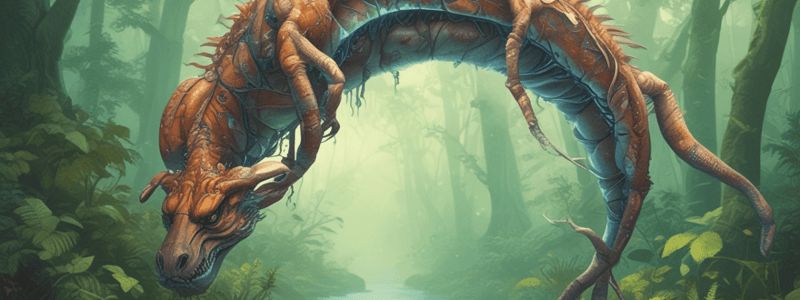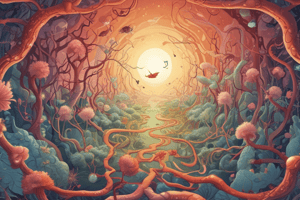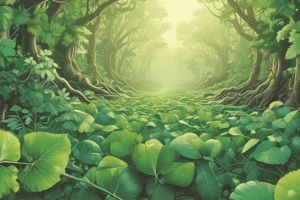Podcast
Questions and Answers
What is the study of interactions between organisms and their environment?
What is the study of interactions between organisms and their environment?
- Microbiology
- Biochemistry
- Botany
- Ecology (correct)
What is the process by which plants and some microorganisms convert light energy into chemical energy?
What is the process by which plants and some microorganisms convert light energy into chemical energy?
- Photosynthesis (correct)
- Cellular Respiration
- Mitosis
- Meiosis
What is the variety of species, ecosystems, and genes in an environment?
What is the variety of species, ecosystems, and genes in an environment?
- Ecosystem
- Ecosystem Services
- Food Chain
- Biodiversity (correct)
Flashcards
Photosynthesis
Photosynthesis
The process by which plants and certain microorganisms convert light energy into chemical energy using water and carbon dioxide.
Cellular Respiration
Cellular Respiration
The process by which cells generate energy from glucose.
Ecosystem
Ecosystem
A community of living organisms interacting with their non-living environment.
Study Notes
Definition and Scope
- Biology is the scientific study of life and living organisms
- Explores the structure, function, growth, evolution, distribution, and taxonomy of all living things
- Encompasses various disciplines, including botany, zoology, microbiology, ecology, and biochemistry
Branches of Biology
- Botany: study of plants and plant-like organisms
- Zoology: study of animals and animal-like organisms
- Microbiology: study of microorganisms, such as bacteria and viruses
- Ecology: study of interactions between organisms and their environment
- Biochemistry: study of chemical processes and substances in living organisms
- Molecular Biology: study of biological molecules, such as DNA and proteins
- Evolutionary Biology: study of the processes that have shaped the diversity of life on Earth
- Genetics: study of heredity, genes, and genetic variation
Biological Molecules
- Carbohydrates: provide energy and structure for organisms (e.g., sugars, starches)
- Proteins: perform various functions, such as enzymes, hormones, and structural components
- Lipids: provide energy and structure for organisms (e.g., fats, oils)
- Nucleic Acids: contain genetic information (e.g., DNA, RNA)
Cell Structure and Function
- Cell membrane: regulates what enters and leaves the cell
- Cytoplasm: jelly-like substance inside the cell membrane
- Nucleus: contains genetic material (DNA)
- Mitochondria: generate energy for the cell through cellular respiration
- Ribosomes: site of protein synthesis
- Lysosomes: contain digestive enzymes and break down cellular waste
Cellular Processes
- Photosynthesis: process by which plants and some microorganisms convert light energy into chemical energy
- Cellular Respiration: process by which cells generate energy from glucose
- Mitosis: process of cell division resulting in two identical daughter cells
- Meiosis: process of cell division resulting in four non-identical daughter cells (gametes)
Evolution
- Theory of Evolution: explains how species change over time through natural selection, genetic drift, mutation, and gene flow
- Natural Selection: process by which individuals with favorable traits are more likely to survive and reproduce
- Speciation: process by which a new species emerges from an existing one
Ecosystems and Ecology
- Ecosystem: community of living and non-living components interacting in a specific environment
- Food Chain: sequence of organisms that eat other organisms
- Food Web: complex network of food chains
- Biodiversity: variety of species, ecosystems, and genes in an environment
- Ecosystem Services: benefits provided by ecosystems, such as air and water purification, and climate regulation
Definition and Scope
- Biology examines life forms, their characteristics, and interactions.
- Covers diverse aspects like structure, function, growth, evolution, distribution, and taxonomy of organisms.
- Major fields include botany, zoology, microbiology, ecology, and biochemistry.
Branches of Biology
- Botany focuses on plant life and plant-like organisms.
- Zoology studies animals and their behaviors and characteristics.
- Microbiology investigates microorganisms, including bacteria and viruses.
- Ecology explores organism-environment interactions.
- Biochemistry analyzes chemical processes in living organisms.
- Molecular Biology delves into biological molecules, such as DNA and proteins.
- Evolutionary Biology examines the processes influencing life's diversity.
- Genetics studies heredity and the variation of genes.
Biological Molecules
- Carbohydrates serve as energy sources and structural components (e.g., sugars, starches).
- Proteins execute various roles: enzymes speed up reactions, hormones regulate processes, and structural proteins provide support.
- Lipids, including fats and oils, are vital for energy storage and forming cell structures.
- Nucleic Acids like DNA and RNA carry genetic information essential for heredity.
Cell Structure and Function
- The cell membrane controls substance entry and exit, maintaining homeostasis.
- Cytoplasm is the intracellular environment where cellular processes occur.
- The nucleus houses the organism's genetic material (DNA).
- Mitochondria produce energy through cellular respiration, essential for cell function.
- Ribosomes are the sites for synthesizing proteins, critical for all cellular activities.
- Lysosomes contain enzymes that digest waste and recycle cell components.
Cellular Processes
- Photosynthesis allows plants and certain microorganisms to convert light into chemical energy using carbon dioxide and water.
- Cellular Respiration enables cells to extract energy from glucose for metabolic processes.
- Mitosis is the process of producing two genetically identical daughter cells, crucial for growth and repair.
- Meiosis produces four genetically distinct gametes, essential for sexual reproduction.
Evolution
- The Theory of Evolution outlines species' transformation over time via natural selection, genetic drift, mutation, and gene flow.
- Natural Selection favors survival and reproduction of individuals with advantageous traits, driving evolutionary change.
- Speciation occurs when new species evolve from existing ones, impacting biodiversity.
Ecosystems and Ecology
- An ecosystem consists of living (biotic) and non-living (abiotic) elements working together in a specific environment.
- A Food Chain illustrates the direct energy transfer between organisms, while a Food Web showcases the complex interconnections between multiple food chains.
- Biodiversity refers to the variety of life forms within a habitat, contributing to ecosystem resilience.
- Ecosystem Services include essential functions like air and water purification, climate stabilization, and nutrient cycling.
Studying That Suits You
Use AI to generate personalized quizzes and flashcards to suit your learning preferences.




